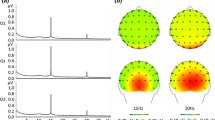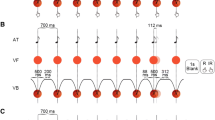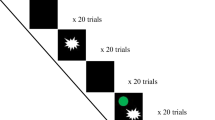Abstract
Relative to audition, vision is considered much less trustworthy in sensorimotor timing such as synchronizing finger movements with a temporally regular sequence. Visuomotor timing requires maintaining attention over time, whereas the sustained visual attention may not be well held in conventional visuomotor timing task settings where flashing visual stimuli consisted of a briefly presented flash and a long blank period. In the present study, the potential attentional lapses in time due to the disappearance of the flash were carefully controlled in Experiment 1 by changing the color of the flash instead of its disappearance, or in Experiment 2 by adding an additional continuously presented fixation point serving as an external attentional cue when the flash disappeared. Improvement of visuomotor timing performance was found in both experiments. The finding suggests a role of enhanced sustained visual attention in improving visuomotor timing, by which vision could also be a trustworthy modality for processing temporal information in sensorimotor interactions.




Similar content being viewed by others
Availability of data and material
The data generated during and/or analyzed during the current study are available from the corresponding author on reasonable request.
Code availability
The codes used during the current study are available from the corresponding author on reasonable request.
References
Bartlett, N. R., & Bartlett, S. C. (1959). Synchronization of a motor response with an anticipated sensory event. Psychological Review, 66(4), 203–218.
Berens, P. (2009). CircStat: A MATLAB toolbox for circular statistics. Journal of Statistical Software, 31(10), 1–21.
Chen, L., & Vroomen, J. (2013). Intersensory binding across space and time: A tutorial review. Attention, Perception & Psychophysics, 75(5), 790–811.
Chen, Y., Repp, B. H., & Patel, A. D. (2002). Spectral decomposition of variability in synchronization and continuation tap**: Comparisons between auditory and visual pacing and feedback conditions. Human Movement Science, 21(4), 515–532.
Colley, I. D., Varlet, M., MacRitchie, J., & Keller, P. E. (2018). The influence of visual cues on temporal anticipation and movement synchronization with musical sequences. Acta Psychologica, 191, 190–200.
Dalla Bella, S., & Sowiński, J. (2015). Uncovering beat deafness: Detecting rhythm disorders with synchronized finger tap** and perceptual timing tasks. Journal of Visualized Experiments, 97, 51761.
Esterman, M., Noonan, S. K., Rosenberg, M., & Degutis, J. (2013). In the zone or zoning out? Tracking behavioral and neural fluctuations during sustained attention. Cerebral Cortex, 23, 2712–2723.
Esterman, M., & Rothlein, D. (2019). Models of sustained attention. Current Opinion in Psychology, 29, 174–180.
Faul, F., Erdfelder, E., Lang, A.-G., & Buchner, A. (2007). G*Power 3: A flexible statistical power analysis program for the social, behavioral, and biomedical sciences. Behavior Research Methods, 39(2), 175–191.
Fisher, N. I. (1993). Statistical analysis of circular data. Cambridge University Press.
Fortenbaugh, F. C., DeGutis, J., & Esterman, M. (2017). Recent theoretical, neural, and clinical advances in sustained attention research. Annals of the New York Academy of Sciences, 1396, 70–91.
Gan, L., Huang, Y., Zhou, L., Qian, C., & Wu, X. (2015). Synchronization to a bouncing ball with a realistic motion trajectory. Scientific Reports, 5, 11974.
Grahn, J. A., Henry, M. J., & McAuley, J. D. (2011). FMRI investigation of cross-modal interactions in beat perception: Audition primes vision, but not vice versa. NeuroImage, 54(2), 1231–1243.
Grahn, J. A., & Rowe, J. B. (2009). Feeling the beat: Premotor and striatal interactions in musicians and nonmusicians during beat perception. Journal of Neuroscience, 29(23), 7540–7548.
Gu, L., Huang, Y., & Wu, X. (2019). Advantage of audition over vision in a perceptual timing task but not in a sensorimotor timing task. Psychological Research, 84:2046-2056.
Guttman, S. E., Gilroy, L. A., & Blake, R. (2005). Hearing what the eyes see: Auditory encoding of visual temporal sequences. Psychological Science, 16(3), 228–235.
Holcombe, A. O. (2009). Seeing slow and seeing fast: Two limits on perception. Trends in Cognitive Sciences, 13(5), 216–221.
Hove, M. J., Fairhurst, M. T., Kotz, S. A., & Keller, P. E. (2013). Synchronizing with auditory and visual rhythms: An fMRI assessment of modality differences and modality appropriateness. NeuroImage, 67, 313–321.
Hove, M. J., Spivey, M. J., & Krumhansl, C. L. (2010). Compatibility of motion facilitates visuomotor synchronization. Journal of Experimental Psychology Human Perception and Performance, 36(6), 1525–1534.
Huang, Y., Gu, L., Yang, J., Zhong, S., & Wu, X. (2018). Relative contributions of the speed characteristic and other possible ecological factors in synchronization to a visual beat consisting of periodically moving stimuli. Frontiers in Psychology, 9:1226. https://doi.org/10.3389/fpsyg.2018.01226
Iversen, J. R., & Balasubramaniam, R. (2016). Synchronization and temporal processing. Current Opinion in Behavioral Sciences, 8, 175–180.
Iversen, J. R., Patel, A. D., Nicodemus, B., & Emmorey, K. (2015). Synchronization to auditory and visual rhythms in hearing and deaf individuals. Cognition, 134, 232–244.
Jacoby, N., Tishby, N., Repp, B. H., Ahissar, M., & Keller, P. E. (2015). Parameter estimation of linear sensorimotor synchronization models: Phase correction, period correction, and ensemble synchronization. Timing & Time Perception, 3(1–2), 52–87.
Kucyi, A., Hove, M. J., Esterman, M., Hutchison, R. M., & Valera, E. M. (2017). Dynamic brain network correlates of spontaneous fluctuations in attention. Cerebral Cortex, 27, 1831–1840.
Lakens, D. (2013). Calculating and reporting effect sizes to facilitate cumulative science: A practical primer for t-tests and ANOVAs. Frontiers in Psychology, 4, 863.
Langner, R., & Eickhoff, S. B. (2013). Sustaining attention to simple tasks: A meta-analytic review of the neural mechanisms of vigilant attention. Psychological Bulletin, 139, 870–900.
Large, E. W., & Jones, M. R. (1999). The dynamics of attending: How people track time-varying events. Psychological Review, 106(1), 119–159.
Mu, Y., Huang, Y., Ji, C., Gu, L., & Wu, X. (2018). Auditory over visual advantage of sensorimotor synchronization in 6- to 7-year-old children but not in 12- to 15-year-old children and adults. Journal of Experimental Psychology. Human Perception and Performance, 44(5), 818–826.
O’Connell, R. G., Dockree, P. M., Robertson, I. H., Bellgrove, M. A., Foxe, J. J., & Kelly, S. P. (2009). Uncovering the neural signature of lapsing attention: Electrophysiological signals predict errors up to 20 s before they occur. Journal of Neuroscience, 29, 8604–8611.
Patel, A. D. (2014). The evolutionary biology of musical rhythm: Was darwin wrong? PLoS Biology, 12(3), e1001821.
Patel, A. D., Iversen, J. R., Bregman, M. R., & Schulz, I. (2009). Experimental evidence for synchronization to a musical beat in a nonhuman animal. Current Biology, 19(10), 827–830.
Patel, A. D., Iversen, J. R., Chen, Y., & Repp, B. (2005). The influence of metricality and modality on synchronization with a beat. Experimental Brain Research, 163(2), 226–238.
Povel, D.-J., & Essens, P. (1985). Perception of temporal patterns. Music Perception, 2(4), 411–440.
Repp, B. H. (2005). Sensorimotor synchronization: A review of the tap** literature. Psychonomic Bulletin & Review, 12(6), 969–992.
Repp, B. H., & Penel, A. (2002). Auditory dominance in temporal processing: New evidence from synchronization with simultaneous visual and auditory sequences. Journal of Experimental Psychology. Human Perception and Performance, 28(5), 1085–1099.
Repp, B. H., & Penel, A. (2004). Rhythmic movement is attracted more strongly to auditory than to visual rhythms. Psychological Research Psychologische Forschung, 68(4), 252–270.
Repp, B. H., & Su, Y.-H. (2013). Sensorimotor synchronization: A review of recent research (2006–2012). Psychonomic Bulletin & Review, 20(3), 403–452.
Sarter, M., Givens, B., & Bruno, J. P. (2001). The cognitive neuroscience of sustained attention: Where top-down meets bottom-up. Brain Research Reviews, 35, 146–160.
Teki, S., Grube, M., Kumar, S., & Griffiths, T. D. (2011). Distinct neural substrates of duration-based and beat-based auditory timing. Journal of Neuroscience, 31(10), 3805–3812.
Thaut, M. H., Kenyon, G. P., Schauer, M. L., & McIntosh, G. C. (1999). The connection between rhythmicity and brain function. IEEE Engineering in Medicine and Biology Magazine: THe Quarterly Magazine of the Engineering in Medicine & Biology Society, 18(2), 101–108.
Varlet, M., Coey, C. A., Schmidt, R. C., Marin, L., Bardy, B. G., & Richardson, M. J. (2014). Influence of stimulus velocity profile on rhythmic visuomotor coordination. Journal of Experimental Psychology. Human Perception and Performance, 40(5), 1849–1860.
Varlet, M., Marin, L., Issartel, J., Schmidt, R. C., & Bardy, B. G. (2012). Continuity of visual and auditory rhythms influences sensorimotor coordination. PLoS One, 7(9), e44082.
Versaci, L., & Laje, R. (2021). Time-oriented attention improves accuracy in a paced finger-tap** task. European Journal of Neuroscience, 54(1), 4212–4229.
Vorberg, D., & Wing, A. (1996). Modeling variability and dependence in timing. In H. Heuer, & S. W. Keele (Eds.). Handbook of perception and action (Vol. 2, pp. 181–262). London: Academic Press.
Zatorre, R. J., Chen, J. L., & Penhune, V. B. (2007). When the brain plays music: Auditory-motor interactions in music perception and production. Nature Reviews Neuroscience, 8(7), 547–558.
Zelic, G., Varlet, M., Kim, J., & Davis, C. (2016). Influence of pacer continuity on continuous and discontinuous visuo-motor synchronisation. Acta Psychologica, 169, 61–70.
Acknowledgements
This work was supported by the Guangdong Provincial Key Research and Development Program (2019B010152001) and the National Natural Science Foundation of China (31971033). The study was performed via the research platform of **ang Wu’s lab, we thank the lab members who have contributed to establishing the platform: Liang Zhou, Lingyu Gan, Cheng Qian, Feiyi Ouyang, Junkai Yang, and Li Gu.
Funding
This work was supported by Guangdong Provincial Key Research and Development Program (2019B010152001) and National Natural Science Foundation of China (31971033).
Author information
Authors and Affiliations
Contributions
YH: methodology, software, investigation, formal analysis. SZ: methodology, software, investigation, formal analysis, writing—original draft, writing—review and editing. LZ: software, formal analysis, writing—review and editing. MS: software, investigation. XW: conceptualization, methodology, software, formal analysis, writing—original draft, writing—review and editing, supervision, funding acquisition.
Corresponding author
Ethics declarations
Conflict of interest
The authors declare that they have no conflict of interest.
Ethics approval
The research protocols in this study were approved by the Institutional Review Board of Psychology Department of Sun Yat-Sen University. The research protocols mostly followed the tenets of the Declaration of Helsinki, with confidentiality and privacy of the collected data protected by the Institutional Review Board of Psychology Department of Sun Yat-Sen University.
Consent to participate
All subjects gave written informed consent.
Consent to publish
All subjects have consented to the submission of the report.
Additional information
Publisher's Note
Springer Nature remains neutral with regard to jurisdictional claims in published maps and institutional affiliations.
Supplementary Information
Below is the link to the electronic supplementary material.
Rights and permissions
About this article
Cite this article
Huang, Y., Zhong, S., Zhan, L. et al. Sustained visual attention improves visuomotor timing. Psychological Research 86, 2059–2066 (2022). https://doi.org/10.1007/s00426-021-01629-9
Received:
Accepted:
Published:
Issue Date:
DOI: https://doi.org/10.1007/s00426-021-01629-9




